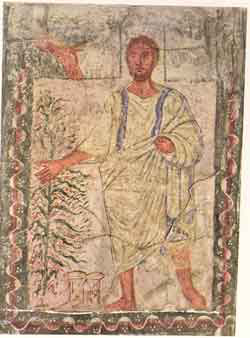Sleeper, awake!
And Jacob went out… Jacob has taken the big step of leaving home, ostensibly to find a wife from among his relatives in Haran, but actually to escape his brother's vengeance. The mother's boy is exhausted. Night settles early and Jacob 'happens on a place' (maqom). Bedding down, he places a stone or stones from the place (maqom) beside/under his head and dreams of a סלם fixed on the ground and reaching toward the heavens. Pay attention to these two items, the ladder and the stones, for their symbolic development.
In the dream God renews his covenant with Abraham and Isaac, promising to give the land of Canaan to Jacob and his descendants and to bring Jacob back to the land from his sojourn abroad.
Jacob is jolted awake, realizing that this maqom is "the house of God and the gate of heaven"—and on rising early the next morning he sets up a memorial pillar with the stone(s) and (typical of his adolescent wheeling and dealing) vows 10% to God conditional upon his safe return home.
Jacob's response to this revelation: "Indeed, God is in this place and I did not know," tells us how unaware he has been, and how the sleeper needs to awaken.
How do artists portray the sleeper in stages toward wakefulness?
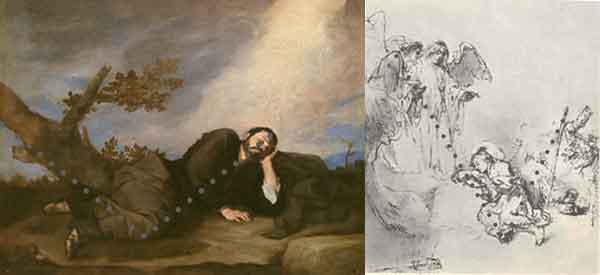
Jose de Ribera, 1639 Rembrandt, 1644
On the left, a man is dead asleep at the roots of a tree; a diagonal column of light floods his face. Seemingly only the title identifies the painting as Jacob's dream. On further inspection we notice that Jacob's body connects the tree with the shaft of light, creating a V-shaped link between earth and heaven in place of the conventional ladder of angels. Trees, like stairs, symbolize the axis mundi, the vertical connection between the material and the spiritual. Ribera's choice to suggest rather than illustrate whets the viewer's own appetite to visualize. Meanwhile this Jacob remains unaware that he is the link.
Rembrandt (on the right), a contemporary, moves beyond Ribera's understatement, but there is still no ladder. Curious angels (not those in the dream), the sleeper and his wanderer's staff, again create a V composition, immediately identifying our scene. In both works, the base of the V marks the maqom. Here, the staff leaning against the tree is the only rigid line, pointing like an arrow to the vertical connection of the axis mundi. Note that in both of these pictures, Jacob's head is positioned upward, perhaps expressing the ambiguity of the phrase "and its/his head reached toward the heavens" – usually understood to refer to the sulam, but possibly meaning Jacob.
Reality and the Dream
In both cases, the artists present Jacob's experience as the viewer would actually see it. Ribera's hints are in the shaft of light and the tree; Rembrandt adds the staff and angels, emblematic of this numinous maqom and outside Jacob's dream. But both differ from many artists, who portray both the dreamer and his dream. For example, Doré differentiates between our view of the sleeper and Jacob's view of his dream, including God enthroned on high. By drawing the dream with softer lines and ethereal light, Doré reveals the vision, but deprives the viewer of freedom to imagine it.
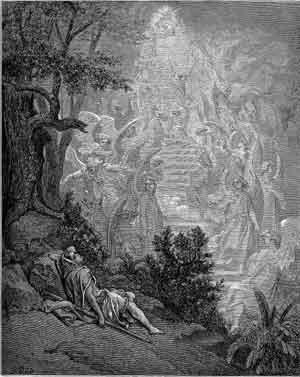
Gustave Doré, 1865
Doré's dreamy bichrome bursts into Technicolor a century later with Marc Chagall and Shalom of Safed.
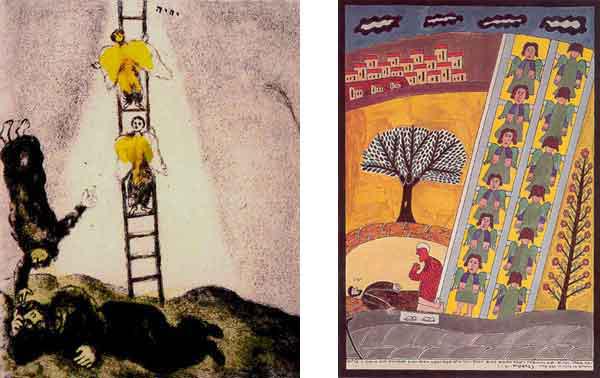
Jacob's Dream, Shalom of Safed,
Marc Chagall, 1939/56 Jacob's Dream, 1967
Doré's treatment is peshat, the plain meaning of the biblical narrative. Chagall and Shalom of Safed, coming out of the traditional Jewish schoolhouse, the heder, add vivid midrashic details to their paintings:
And he dreamed, and behold a ladder set up on the earth, and
its head reached toward heaven; and behold the angels of God
ascending and descending on it. And, behold, the Lord
stood עליו....
With hutzpah, these two well-known Jewish artists of the 20th century play with the strange phrase: "God is standing on it/him". It is surprising enough that an anthropomorphic God is standing there to begin with, earthbound. But the word עליו is ambiguous. Is God standing on Jacob or on the ladder? For Chagall, God is doing a handstand on Jacob. For Shalom, a bizarre red-scaled God is standing by Jacob. Both artists seem to be influenced by a daring Midrash in Bereishit Rabba 69: 3, which declares that God enters history by means of people.
This Midrash wrestles with the multiple meanings of both components of נצב עליו:
nasab can mean standing or enduring
alayv in this context can mean on, near or by means of/through
Accordingly, God is standing by Jacob = God is supported by Jacob = God is realized through Jacob (as initially through Abraham), hence the phrase "God endures by virtue of the righteous". Ironically, Jacob is still asleep.
Despite the well-known prohibition of images, neither of these Jewish artists avoids painting God, since in this way they show that through Jacob, God's presence is affirmed.
A Horizontal Ladder
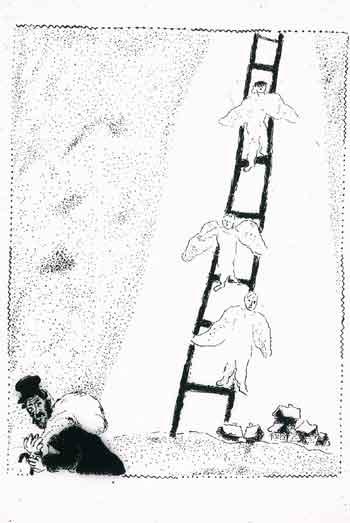
Marc Chagall, 1938
Another Chagall drawing, from 1938, accompanies a poem entitled “Do not fear, my servant Jacob” from 1920 by the Yiddish-American poet A. Liessin (Walt).
I see him blundering on his way to Haran
the first Jew going his golus-way
The blessing by dirty tricks, the birthright by swindle
frightened, running from Esau
of all his shtick only the wanderer's staff is left
he dreams a ladder rising all the way to heaven
a stone by his head, all around a demonic world
but he sees only angels and hears in great ecstasy,
"fear not my servant Jacob"
Both Liesen's excerpt and Chagall's drawing reflect the panic of Jews in flight between the World Wars.
In this version of the story, Chagall portrays Jacob as leaving the shtetl with his pekel. Jacob will be moving in two directions: the ladder is the vertical connection with God, which accompanies him on the horizontal road abroad. This is the motif of ויצא: the simultaneous vertical and horizontal journey of the Jew. Ironically, he leaves the land of Israel with the resident angels ascending the ladder and will return with the descending angels. Jacob will be fully awake only on his return.
In fact there is a third axis here, the axis of time. As Liessin suggests, Jacob of Genesis 28 is the historical people of Israel, until today. One midrash already interprets Jacob's dream as a prophecy of Israel's entire history. In order to appreciate this axis, we must return to the ancient past. Time out for an archaeological detour.
The Sulam in the Ancient Near East
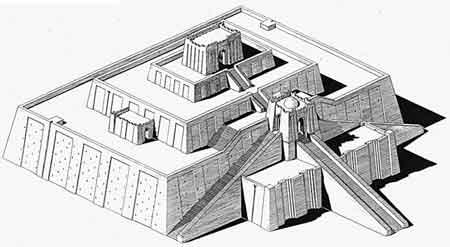
Ziggurat of Ur-Nammu
Since the rediscovery of the cultures of the ancient Near East at the end of the 18th century (with Napoleon's Egyptian expedition), western scholarship has come to see the Bible as reflecting the dual influences of Egypt and Mesopotamia. For example, the tower of Babel in Genesis 11 recalls the main temple in the city of Babylon, a stepped tower or ziggurat, "whose head is in the heavens." Babel itself is literally "the gate of the gods," (bab el, in Akkadian), a term analogous to Jacob's exclamation at Bethel (bet el, the house of God) "this is the gate of heaven."
Sulam, otherwise unattested in the Bible, is generally understood to mean ladder. But many modern scholars take סלם to mean "stairway" or "ramp," from the Akkadian word simmiltu. Jacob sees angels ascending and descending the ramp/ladder/stairs, while in a famous Assyrian tale minor gods ascend and descend the simmiltu as messengers (מלאכים = angels) between the gods of heaven and the underworld.
The other side of the Fertile Crescent provides an additional perspective on the ladder. Climbing to heaven is an important motif in Egyptian religious literature, centering on the god of the afterlife, Osiris, who is frequently called "the god at the top of the staircase or ladder." In many cases, Osiris is the ladder, as represented in the djed pillar, symbol of transcendence. "His ascension and resurrection reflect a psychic transformation, which is mythologically projected as the union of the lower (earthly) Osiris with the higher spiritual soul."
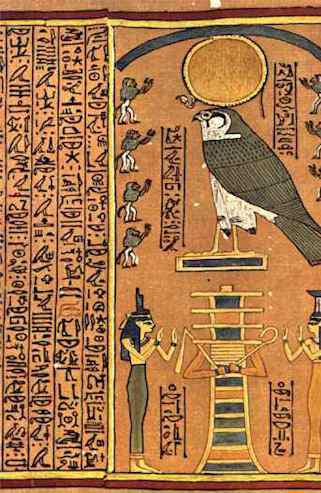
Learning of the djed and its associations reminds us of the puzzling dual appearance of Jacob in an early midrash, asleep at the foot of the ladder and radiant at its head. Angels are laughing at Jacob (see Rembrandt below), because of the contrast between the clueless sleeper and an image of the idealized Jacob set into the divine throne (see the Golden Hagaddah, below). It appears that the ambiguous phrase "and his/its head reached toward the heavens" produced this midrash. Jacob below and above in the midrash is similar to the earthly and the spiritual Osiris as the djed pillar. This does not necessarily mean that the Jacob story is derived from Egyptian mythology, but rather that there are parallels, based on universal aspects of the human psyche.
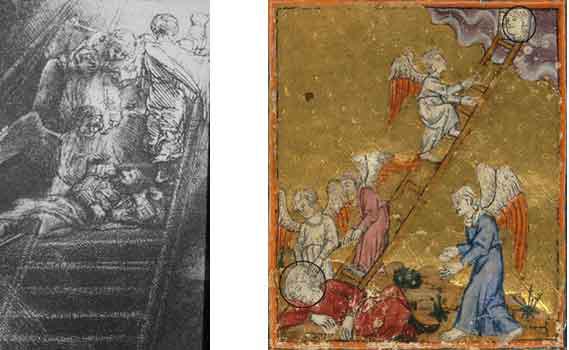
However, our Jacob is no divinity, but a human (all too human), who will struggle to transcend himself. This will be seen in his return trip to the land of promise.
Jacob's Pillow?
But we have left a stone uncovered, the stones of Jacob's pillow.
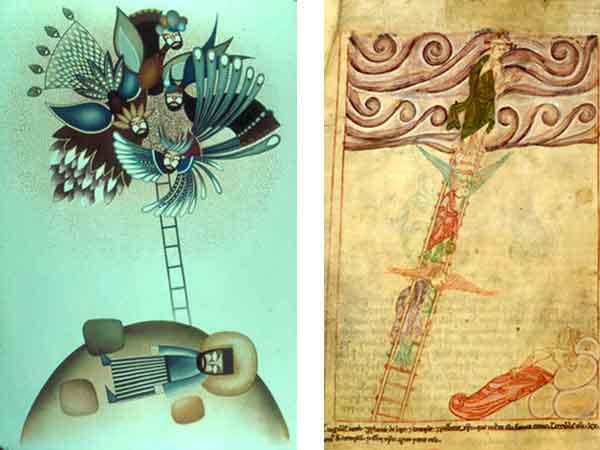
Jacob's Dream, Old English Translation of the
David Sharir, 1970 Hexateuch by Aelfric, 1025
In an 11th century Anglo-Saxon illustrated manuscript of the Aelfric Paraphrase (on the right), Jacob's cushy pillow consists of four marshmallows. In a contemporary Israeli miniature of David Sharir, Jacob lies on one pillow, surrounded symmetrically by the other three.
Why four? The Bible mentions both "stone" (verse 18) and "stones" (verse 11) evoking midrashic playfulness: two, three, four and twelve stones!
In this midrashic numbers game, the stones are the generations of the patriarchs (two and three), the tribes of Israel (twelve), the cardinal directions of the land of Israel (four) – thus they concretize the two aspects of the divine promise: land and people. Finally, the many stones roll into one when Jacob sets up a memorial.
Similarly, pilgrims to Osiris' main shrine at Abydos would set up stone monuments at the base of the mythical ladder.
In the biblical vision, God asserts that Jacob will burst out in four directions. Sharir marks the cardinal directions with Jacob at the center and the ladder directly above him. Both he and the ladder are emerging from the "earth's navel" (tabur ha'aretz). The many stones have become the one "foundation stone"—the sacred center—where the sanctuary will rise in Jerusalem. But isn't Jacob at Bethel (see v. 19)? Thus the sacred center, the axis mundi, is at one and the same time in Bethel, Jerusalem, Sinai, wherever there is a conscious connection with God.
For additional images on this subject see TALI Visual Midrash



